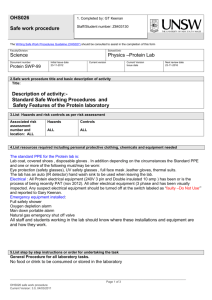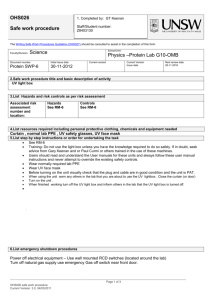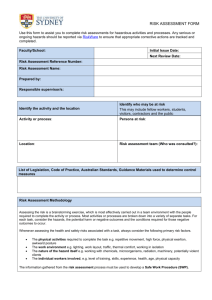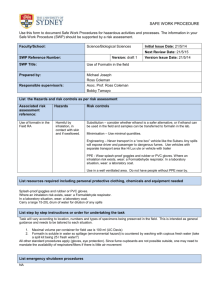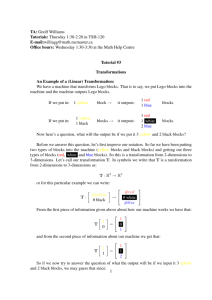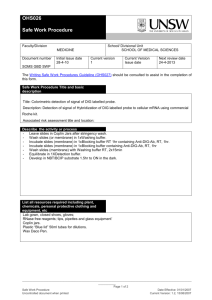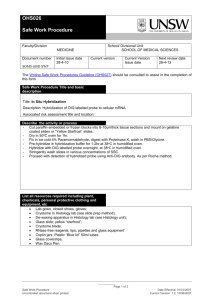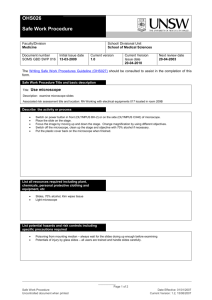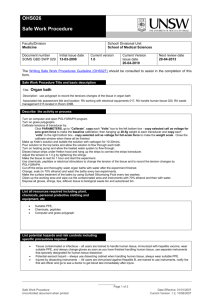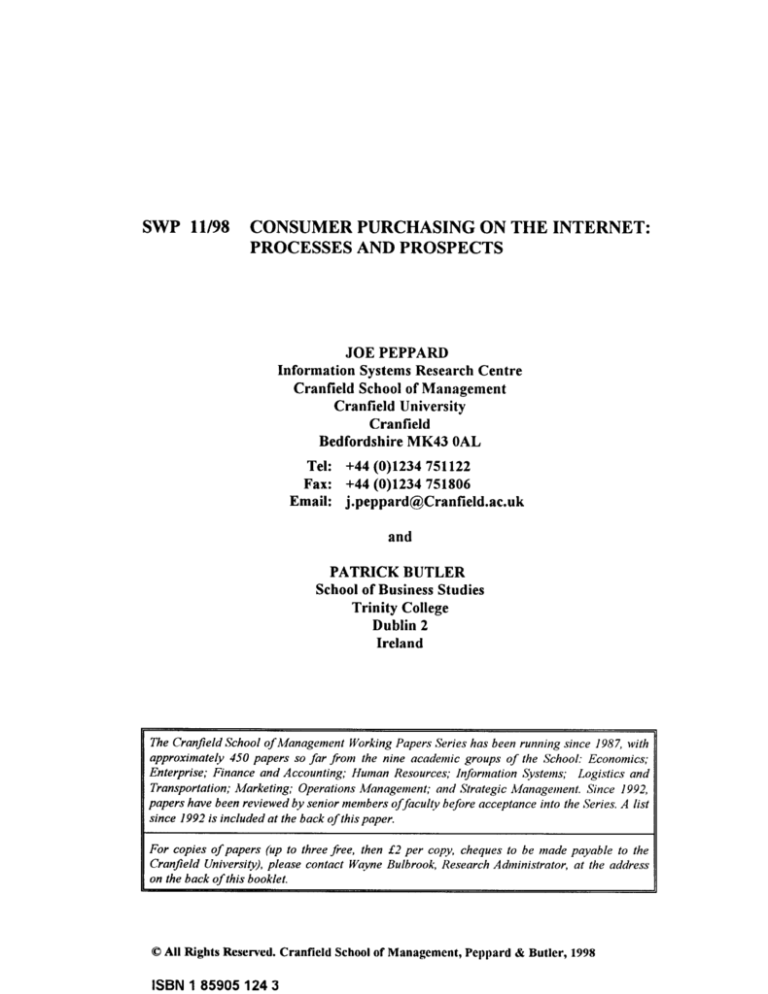
SWP 1 l/98
CONSUMER PURCHASING ON THE INTERNET:
PROCESSES AND PROSPECTS
JOE PEPPARD
Information Systems Research Centre
Cranfield School of Management
Cranfield University
Cranfield
Bedfordshire MK43 OAL
Tel:
Fax:
Email:
+44 (0)1234 751122
+44 (0)1234 751806
j.peppard@Cranfield.ac.uk
and
PATRICK BUTLER
School of Business Studies
Trinity College
Dublin 2
Ireland
The CranJeld School of Management Working Papers Series has been running since 1987, with
approximately 450 papers so far from the nine academic groups of the School: Economics;
Enterprise; Finance and Accounting; Human Resources; Information Systems; Logistics and
Transportation; Marketing; Operations Management; and Strategic Management. Since 1992,
papers have been reviewed by senior members offaculty before acceptance into the Series. A list
since 1992 is included at the back of this paper.
For copies of papers (up to three free, then f2 per copy, cheques to be made payable to the
Cranjield University), please contact Wayne Bulbrook, Research Administrator, at the address
on the back of this booklet.
0 All Rights Reserved. Cranfield School of Management, Peppard & Butler, 1998
ISBN 1 85905 124 3
Consumer Purchasing on the Internet:
Processesand Prospects
Patrick Butler
School of Business Studies,
Trinity College,
Dublin 2
Ireland
and
Joe Peppard
Information Systems Research Centre,
Cranfield School of Management,
Cranfield,
MK43 OAL
UK
ABSTRACT
Much of the business transacted over the Internet today is in the business-toOutside of specialised niche areas like information
business sphere.
technology and other information-based products, business-to-consumers
commerce is relatively undeveloped One principle that holds true in the
marketspace is that before cybermarketers can effectively respond to
consumer demand, they must understand consumer behaviour. Internet
marketers should revisit traditional models of consumer behaviour, examine
their underlying assumptions, and explore their validity in the new Internet
context. A standard model of the consumer buying behaviour processes is
applied to purchasing situations on the Internet, with a view to comparing
traditional marketplace transactions with the emerging virtual marketspace.
Understanding consumer behaviour in Internet purchasing remains the
marketing management imperative.
Submission
for European Management
Journal
Consumer Purchasing on the Internet
Consumer Purchasing on the Internet:
Processesand Prospects
The growth in interest in the Internet as a shopping and purchasing medium is fascinating for
practitioners and observers alike. In stimulating a techno-economic paradigm shift, the
Internet is causing a re-evaluation of traditional assumptions underlying the conduct of
business. Despite the hype of on-line retailers, website developers and many observers,
however, there have been serious casualties in the field in the early battles to win ground in
this new colonisation. The early fallout of IBM’s sponsored web shopping malls, for
example, are due in part to unrealistic expectations of the demand potential in the field,
technology problems, and rather naive understandings of the true nature of competition in the
new world. Yet despite these initial tribulations, the Internet and World Wide Web (WWW)
do open up a vast arena providing both opportunities and challenges.
Much of the growth in revenue from business transactions over the Internet has been fuelled
by business-to-business exchanges. The result is that there is a considerable and growing
body of knowledge, experience and expertise in the field of business-to-business electronic
commerce. Yet with the exception of software, books, some travel services and a few other
niche areas, that same depth of understanding has not been achieved in the individual
consumer field. To exploit this new medium requires not just an understanding of consumer
behaviour and the consumer decision making process, but of how new technologies challenge
the traditional assumptions which underpin conventional theories and models.
Critical to understanding consumer behaviour in cyberspace, as in the physical world, is to
understand how the individual consumer makes purchase choice decisions. That is, if
cybermarketers know how the purchase decision is made, and identify the stages in the
purchase decision, then they can analytically follow through in developing marketing
strategies. The primary purpose of this paper is to outline the traditional consumer buying
decision process and compare it with Internet buying behaviour.
Some of the important issues in the information economy are first noted, focusing
particularly on the implications for marketing. In order to set reasonable parameters to the
paper, a classic typology of consumer purchasing situations is presented. Internet purchasing
in terms of this model is then assessed,and the critical issues are identified. Finally, the
marketing tasks and strategic directions at each stage of the buying decision process are
outlined.
The information economy
The emergence of the information economy has been predicted for generations. While
descriptions of this new era vary from the speculative, as captured in popular cyber-novels
(Gibson, 1984), to the more polemic (Negroponte,l995), what is common is that this
emerging era will have fundamental impacts on all aspects of social, economic, business and
political life. Already the very nature of business itself has been affected. Indeed, the US
federal government recognises the dynamic by now collecting economic data using a revised
classification system which explicitly captures “information” jobs.
Consumer Purchasing on the Internet
This new era is being brought about by a number of developments, including (i) rapid
technological convergence, (ii) greater connectivity, (iii) enhanced interactive capacity, and
(iv) increased organisational co-ordination capability/options (Butler et al., 1997; Malone et
al., 1987; Yoffie, 1996). And it is perhaps the Internet which is making the information
economy visible for the ordinary consumer.
The convergence of digital technologies is blurring the traditional distinction between entire
industries. Distinct sectors are seen to fuse in a digital environment. Who, for example, can
be sure where the computer industry ends and the telecommunications industry begins?
Disaggregation of existing value chains and the formulation of new information-based virtual
enterprises make for particular challenges in industry analysis. Such technological
convergence is leading to the growth of new products and services with overlapping
functionality. While offering more solutions to consumer’s problems, they also serving to
confuse consumers.
Connectivity refers to the ability of consumers to access and participate in Internet
communications. One of the consistent lessons of technological innovation is that the
agreement of standards stimulates both uptake of new technologies and investment. The
classic example is the technically superior but proprietary Apple Macintosh computer losing
out to the open architecture of the IBM compatible machines. More recently, the exponential
growth in mobile phones is largely due to the GSM standard. A similar openness now
pervades today’s network technologies making it easier to connect to global networks.
Marketers in the new domain must follow closely the battles for standards - the final choice
at the consumer level may be constrained at first by the adoption of a single standard, but
widespread uptake will enable economies of scale and consequent advantages.
Unlike older technologies, new information technologies provide for true interactivity
between buyer and sellers. This interactive element is of crucial importance, since much of
business activity consists of interactions (human and technical communication, data
gathering, collaborative problem solving, negotiation). Indeed, a recent McKinsey report
suggests that 5 1% of US, and 46% of German, labour costs are accounted for by interactive
events (Butler et al., 1997). Technology increases our capacity to interact and serves to
decrease the amount of time spent on such activities, a time which not only incurs cost but
may add little value.
For organisations, new technologies have also increased the range of options available in
relation to co-ordination, permitting new configurations of both intra- and interorganisational activities. The vertically integrated firm, with the traditional advantages of
coordination and control, is giving way to new structures. For instance, where a massive
physical asset base of buildings, equipment and transportation might have been
advantageous, it may now only restrain the flexibility of the organisation as it decouples the
potentially valuable elements of its value chain. The virtual organisation, a grouping of
distinct entities that each contributes unique competencies to a specific business project and
eventually disbands on completion, is common in some industries. For example, Italian
motorbike marque Aprile is not made by one company or one leader company, but represents
the joint efforts of many companies, each bringing their particular strengths to bear.
Competing in the information economy
Competing on the Internet is different from competing in the traditional industrial world.
Competition no longer takes place in the physical marketplace but in the marketspace
(Rayport and Sviokla, 1994).
This computer-mediated environment has profound
Consumer Purchasing on the Internet
implications for how business is transacted between buyer and seller. The content of the
transaction is different in that it is based on information about the product or services rather
than on its physical appearance or attributes. The context of the transaction is different;
instead of taking place in a physical world, it occurs in a computer-mediated environment
with the buyer conducting the transaction from a computer screen. Consequently, to be a
player in many industries does not require a physical infrastructure like buildings and
machinery; a computer and communications platform is sufficient.
Internet dynamics
For the marketer, the Internet poses many challenges. In particular, the virtual medium
provided by new technologies challenge not only traditional theories of marketing but the
very practice of marketing itself. A number of significant shifts can be discerned in the
development of such business:
From broadcast to narrowcast
Technology renders obsolete the traditional one-to-many model of mass marketing
communication. One-to-one communication between seller and buyer is now easily achieved
(Hoffman and Novak, 1996). Communications can also be geared to take account of such
individual factors as demographic profile, lifestyle interests, shopping behaviour, purchasing
history and so on. Mass customisation becomes possible with both products and
For example, Crayon.com enables
communications being customised to individuals.
individuals to create their own newspapers from many international sources based on their
individual preferences. In constructing this customised newspaper, the consumer might
choose to have his world news from The Los Angeles Times, local news from The Irish
Times, sport from Le Monde and culture from Die Welt.
From passive surfer to interactive buyer
Today’s consumer is an increasingly proactive consumer. He or she is less likely to be a
passive absorber of the marketer’s message, and more likely to have been directly involved in
its development. Communications between the parties may have enabled the potential buyer
to specify their interests and request the seller to keep them informed of updates, upgrades or
just relevant news. “Push” technologies encourage the consumer to outline either the general
or specific nature of their interests, and invite all comers to supply the information and offer
the deal.
From limitedphysical
space to unlimited virtual space
In this new world, presence is not achieved by purchasing limited physical space as with
newspapers, magazines or billboards. Space is unlimited to the extent that it can be easily
increased, although there are limitations to what one can place on a single web page. Perhaps
the unique characteristic of business on the Internet is its unconstrained physical space.
Organisations and people are no longer confined by physical infrastructure like plant and
office buildings. Newspapers, for example, are no longer bound by traditional publishing
economies of scale.
ConsumerPurchasing on the Internet
From advertisement to electronic trade show
The traditional newspaper advertisement or brochure setting out the sellers’ wares has both
scope and scale limitations. The technology now exists to transform such a medium into an
electronic trade show. When speed is an important criterion for success, the challenge is to
convert quickly visitors into leads and then into customers.
Internet as media
The medium of the Internet is, therefore, not only provides information, albeit of a richer
nature than in the marketplace, but is also a mechanism for communication, an environment
for conducting the transaction, and possibly a channel for actually delivering the product or
service to the consumer (Angehrn, 1997).
As a medium for information distribution and dissemination, the Internet accesses a global
audience. Unlike traditional communications media, the use of voice, video, text and images
provide a richer picture of the company’s wares. Information can be tailored to the
requirements of the consumer either by eliciting information from them or through the use of
tracking technologies.
As a medium for communicating with customers or potential customers, the interactive nature
of the Internet allows the marketer to establish an active dialogue with consumers. By using
email, on-line forums or a more advanced interaction space, information and opinions can be
exchanged in a two-way process.
As a medium for conducting transactions, orders, invoices and other business documents can
be sent electronically. Payment can also be made electronically using a credit card although
in the future the ‘electronic purse’ may enable micro payments to be made.
As a distribution medium, the Internet enables certain products and services to be easily
delivered to consumers without geographical limitations. Obvious examples include software,
music and other digital-based product. Less obvious ones include consulting services such as
Ernst & Young’s on-line consulting site. It may also be possible to increase the value of a
core physical product through capitalising on information. This what Federal Express have
achieved by permitting customers to enquire into the status of their package shipments using
the WWW.
Understanding
consumer behaviour
Despite such fundamental change in the structure and process of buying and selling, one
principle which holds true in the marketspace is that before marketers can effectively respond
to consumer demand, they must first understand the consumer. There are general models of
buying behaviour that enable an understanding of the process which consumers follow in
making a purchasing decision. These models provide explanatory and predictive ability
which are of critical importance to marketers.
The changing market environment is highly complex, and can be subjected to analysis from
many perspectives. At the broadest level, the new economics of information addresses the
uncoupling of information from the physical value chain and the effects on industry
structures and processes (Evans and Wurster, 1997; Rayport and Sviokla, 1995). At the
intermediate level of trading, the primary concern is interactivity (Butler et al., 1997). At the
level of the individual consumer, however, the new concerns are the process by which
consumers make decisions in the new environment (Peterson et al, 1997). It is certainly the
Consumer Purchasing on the Internet
case that new models of web-based purchasing behaviour will only be developed and finessed
through ongoing research and application. Generic models suffer the natural weakness of
being too general to guide marketing activity, whereas models of specific situations are often
not generalisable. Nonetheless, the purpose here is to set out the basic elements of the
purchasing situation and to compare the traditional with the new.
Purchasing categories
The classic typology of purchasing categories is set out in figure 1. This schema portrays a
continuum extending from routine problem solving behaviour through limited problem
solving to extensive problem solving. Any buying situation will be placed along the
continuum according to the degree of active reasoning required for a particular purchasing
decision.
Problem solving
Routine
behaviour
Limited
Perceived risk
Low
High
4
4
Frequency
Extensive
W
High
w
Low
*
High
*
Low
*
High
*
High
Price
Low
4
High 4
Low
Low
4
4
Experience in purchasing product
Involvement in purchasing process
Information content for decision
Figure 1 Consumer purchasing and characteristics of the purchasing decision.
Routine problem solving behaviour, typified by the purchase of a newspaper or chocolate bar,
is a simple and straightforward task for the individual. The consumer is comfortable and
experienced in the process, and it is perhaps something that the consumer does on a daily
basis. There is no great sense of personal involvement in the purchase - the individual will
hardly be judged on the purchase, the price is low, and the risks associated with getting the
wrong product are negligible. At the other extreme, however, typified by the purchase of hi fi
equipment, a car or an apartment, is the extensive problem solving situation. Here, there is a
great sense of personal involvement in the decision, the purchase is infrequent and so the
consumer does not have any or much experience in the process, and the perceived risks are
high. Between the two extremes is the limited problem solving situation. When involvement
is relatively low, when the alternatives are not perceived to be widely differentiated, and
when the time frame is relatively short, then this situation prevails.
For the purpose of comparing the issues in the decision process between an individual
shopping in the physical world and on the Internet, we will examine the extensive problem
solving (EPS) situation in the first instance. This is appropriate early in the life of consumerlevel electronic commerce, given the lack of experience of potential customers, the perceived
risks in payment security, and the time taken to learn and become familiar with the purchase
routines on the Web. With experience, however, many such purchases will be more
realistically categorised as limited problem solving (LPS).
ConsumerPurchasing on the Internet
The consumer decision process
The modelling of consumer decision making enables managers to explain and predict
consumer behaviour, and thereby provides a basis for marketing decisions. The traditional
framework for analysts of the LPS and EPS buyer decision processes is a linear stages model
of five key steps, as outlined in Figure 2. Of course, iteration exists between the stages.
Indeed, given the speed at which information is now updated, it could be argued that the
loops backward in the model are increasingly important (Zellwegger, 1997). Nonetheless, the
general thrust is forward through the stages. The consumer progresses firstly from a state of
felt deprivation (Problem Recognition) to the Search for Information on possible solutions.
The information gathered, be it from internal sources (e.g. memory) or external sources (e.g.
discussions, brochures, sales promotions) provides the basis for the next stage - the
This stage requires the development and comparison of
Evaluation of Alternatives.
purchasing evaluation criteria.
Figure 2 Consumer behaviour and the purchasing decision.
The Choice/Purchase stage concerns the action or activity of the purchase, and includes such
issues as the place and means of purchase as well as the actual decision to buy. Finally, PostPurchase behaviour, as an explicit stage in the process, is critical in the marketing
perspective. The degree of satisfaction/dissatisfaction with the product/service is a major
concern of marketers, and provides information for future products and services. This
framework is useful in enabling the complexities of the external environment and internal
information processing to be captured. Each of these stages is now examined in turn and
compared in the context of the marketplace and the marketspace. Figure 3 provides an
overview.
Problem recognition
The first stage of the consumer decision process triggers all subsequent activity. The
consumer is compelled to fill the gap between the actual state (deprivation) and the desired
state (fulfilment) when his or her threshold of problem awareness is reached. Problem
recognition may be triggered by a number of external or internal factors. For example, an
increase in a person’s financial situation can trigger a consumption decision; running out of
stock results in a depletion that requires restocking; marketing stimuli, such as a new product
Consumer Purchasing on the Internet
announcement or sales promotion campaign, may lead the individual to perceive a particular
want for the product.
Consumer
issues
-
Marketplace-
Marketspace
-
Marketing issues
Marketing issues
m Need awareness
* Problem definition
. Problem articulation
* Consumer identification
* Problem recognition
. Stimulate search interest
* Databases to know customer
. Sources of information
* Accessibility of information
. Reliability of information
. Attract searchers
* Provide information
* Advertising in the marketplace
media
* Links from other sites
* Quality of information
. ‘Push’ technologies
. Comprehensiveness
of
information
. Trust and confidence in
information
. Trial and sampling
* Influencing purchase
criteria
. Provide testing/sampling
opportunities
* Build brand preference
* Virtual communities and user
groups endorcements
* Simulation and testing
opportunities
. Negotiation process
* Transaction process
. Management of the
exchange process
* Management of supply
* After sales support
* Relationship support
* Service support
* Problem recovery
* Relationship
management
Choice/
Purchase
* Ease of ordering and delivery payment, security, conditions
c
* On-line support
* Relationship building with
consumer, user groups and
virtual communities
Figure 3: Consumer marketing issues in the marketplace and the marketspace.
Consider the external marketing stimuli: In traditional markets, conventional marketing
communications stimulate demand via conventional media, e.g. an advertisement on
On the internet, however, the medium is new, and so new kinds of
television.
communications are required. Traditional mass marketing approaches such as advertising
reflect the one mass marketer communicating a common message to many consumers. Of
course, much of the audience will not be interested, and there is considerable wastage. But
new information technologies fundamentally change that. Computer-mediated environments
enable identification of individual consumer needs and wants, and the subsequent design and
delivery of individual, customised communications to the one individual by many suppliers.
This, then, supersedesthe traditional “one-to-many” practice.
In terms of consumer problem recognition, the Internet marketer can capture the consumer at
this early stage in the process. That is, the marketer, by virtue of powerful databases of
consumer information, is in a better position to know and anticipate the consumer’s needs
and wants. Furthermore, the problem thresholds that will trigger action may also be known.
Indeed, the marketer may be in a position to manage the consumer’s purchasing function in a
way that has only been known in business-to-business markets heretofore. For instance, the
benefits of ED1 emphasise the effectiveness of automatic reorder prompts at specific stocks
levels, product and service updates, and automatic upgrades for valued customers. These all
make the decision less complex for the buyer, and more manageable and effective. Such
relationships are now increasingly possible at the consumer level.
ConsumerPurchasing on the Internet
Direct marketing activity in recent years has been based on this kind of relationship potential.
But the leap forward of the Internet will be largely empowered by tracking technologies. A
“cookie” tracking devise will enable “click stream” analysis of individuals, such that their
browsing activities, interests and purchase behaviour may be exactly known to the marketer.
Then, by solicitous communications, the consumer may be contacted on the basis of his or
her specific needs and wants as determined by behaviour pattern analysis. The relationship
development advantages accruing to the pioneers of such analytical and communication
technologies are enormous. The problem recognition stage in the purchase decision process
remains essentially the same, but the potential for marketer-consumer relationships is
enhanced.
The primary strategy issues for marketers at this stage in the process are the development of
communications technologies that will enable the degree of customer relationships wherein
the consumer’s problem recognition will be anticipated, or even triggered, by the seller.
Information
search
Whereas the problem recognition stage motivates the consumer to act, the information search
stage is when the consumer takes action to gain knowledge. The sourcing of information is at
the heart of this stage in the consumer buying decision process. Essentially, the consumer
seeks information for decision-making, and the marketer must provide the necessary
information.
The management of information is the primary role of the agent or broker in the marketplace
This is the effective function of travel agents, for instance. But, in the marketspace, when an
airline sets up its own website with interactive flight information and booking facilities, for
example, then the traditional intermediary is bypassed in a classic case of dis-intermediation.
So, the information can be sought and accessed directly by consumers because of information
technology developments. Critically, the information provider or broker can no longer
survive in a passive role.
The emphasis has moved from a total reliance on attracting visitors to the seller. The
emergence of new push technologies means that communications can now be sent routinely
to targeted recipients who are known to be interested parties by virtue of their earlier visits to
the website, their queries and their general Internet browsing and shopping behaviour. That
is, the information search stage in the framework is anticipated with greater clarity and focus;
the ability of the information provider to proactively locate the interested searcher and
provide the desired information is now hugely enhanced. Consumers may register for
continual information updates and routinised offer information at no charge. Information is
virtually free, and the costs of accessing information are negligible. Given the free flow of
product information in the marketspace and the potential for overload, the marketer with the
best-designed information package will generate the competitive advantage.
Webcasting is a way of pushing information out across the Net rather then waiting for
consumers to find it. PointCast is one such Internet service which literally broadcasts news,
sport, weather reports, stock prices and other information directly to a PC in a personalised,
easy-to-digest newscast. There is now no need for broad-based surfing: the information finds
the subscribers once they have specified the information they want to receive. In what is the
equivalent of the screen saver, PointCast converts the idle computer screen into an eye
catching TV-like newscast when the computer is not being used.
ConsumerPurchasing on the Internet
As individuals come to utilise the Internet for consumer purchases, a situation of perfect
information is almost attainable. However, it must be noted that consumers’ sense of
uncertainty can actually increase as they gain more information. Information “overload”
occurs when we learn more about the alternatives available to us, and the search becomes
“psychologically costly” (Wilkie, 1994). When humans cannot plot or track the totality of
information, they deliberately simplify their problem - they develop heuristics that must be
recognised by marketers. Chief among these, for the marketer, is brand loyalty and all that
goes with the development of a brand - identity, reliability, trust.
For the marketer, the strategy issues related to this stage of the process revolve around
attracting information-seeking consumers and providing the information they require. In the
marketspace, this demands a good net presence at the very least. In traditional markets, the
intermediary function is largely based on information provision and exchange. As
communications technologies change and as channel dis-intermediation and re-intermediation
become more common, matching information content with the consumer’s requirement,
while continuing to be fundamental to success, will require new approaches to information
provision and exchange.
Evaluation of alternatives
The third stage of the consumer buying decision process involves the analysis and evaluation
of alternative solutions. So, the consumer has sought and found the relevant information, and
must now use it to make the purchase decision. Traditional sources of information for the
evaluative stage include past experience, marketing-sponsored communications, consumer
groups and research institutions, and word-of-mouth.
In Internet markets, however,
information technologies allow for more, and more defined, evaluative criteria to be used. In
this regard, when consumers experience information overload in the evaluation process, or
when the “psychological price” of evaluation becomes too high, the advantage may be to the
“safe” branded or established competitor.
The counterpoint to this, however, lies in the comparative possibilities of newly developing
intelligent shopping agents. CompareNet, for instance, has a programme that for a wide range
of goods and services will search the Web for the product the consumer specifies. Then, it
will help the consumer to choose and arrange the relevant criteria for the evaluation of that
product. Finally, it will instantly produce tabulated data that allows the buyer to compare the
options. The service provides simple definitions of these criteria and indicates why they are
important in the purchasing decision. This educational role is also enhanced with buying tips
to empower the buyer
While this would appear to be a very democratic model, already several web sellers are
blocking such shopping agents from their sites, notably in the music CD field. Despite this
setback, however, we can expect this service for almost any purchase imaginable in the near
future. Of course, it is clear that the competitor without an Internet presence cannot even get
to the point of being considered.
It would be naive to think that the Internet provides only a simple visual evaluation.
Imminent developments will enable highly sensory interactivity. Already, three-dimensional
representations can “walk” a consumer through a new apartment, clothing can be “tried on
and modelled”, and technologies such as WAV and Real Audio transmit selections of music
for the potential purchaser. Virtual reality test drive simulations are developing rapidly, and
soon Aldos Huxley’s “feelies” may not be the absurd scenario that was once sneered at.
ConsumerPurchasing on the Internet
In this arena of powerful information forces we should not be dismissive of simpler
approaches to evaluating alternative solutions to problems. In the same way that word-ofmouth communication and the reference of family and friends is a central influence at this
stage of the decision process in the traditional marketplace, new kinds of reference groups
are central in the marketspace. In effect, a discussion group of interested parties in any field
serves this role in the new environment. The virtual community can have all the power of the
traditional reference groups but with even greater quality and quantity of evaluative
information available to it and the means to share that information (Hagel, 1997). The notion
of community can convey enormous credibility on the information source. Ideas and
proposals are vetted by and with trusted colleagues in the community. The best-known
online communities include Agriculture Online, Garden Escape and Mums Online.
In the entertainment field, for instance, Firefly.com has proven to be an exciting and
successful source for information searchers. It is, by nature and design, a body of like-minded
individuals whose patterns of entertainment consumption are similar and who share freely
their knowledge of, and views on, a wide variety of goods and services. Even simpler
versions of virtual communities are typified by Amazon.com’s (the world’s biggest
bookseller site) open book reviews, whereby a potential buyer can read book reviews by other
website visitors.
For the marketing strategist, the first issue for alternative evaluation is to understand the
criteria employed by the consumer to evaluate the product, the preferences of the consumer,
and the positions of competitors on these criteria.. This is underlined when the comparativetype search engines described increase in popularity. Corporate identity and branding
strategies are also relevant here, and the Internet will provide opportunities for exciting new
brands.
Purchase decision
The purchase stage of the process involves decisions on where and how to buy. A core
question concerns why people go shopping. Consumers do not shop only to buy. Personal
shopping motives include diversion from daily routines, self gratification, learning about new
trends and physical activity. Among the social motives are communicating with others with
similar interests, peer group attraction and the pleasure involved in bargaining and haggling.
So, the investigation of these kinds of motives between physical shopping and Internet
shopping also requires comparison.
Where to buy is a decision regarding the choice of seller. Competition on the web is driven by
sellers attempting to build more exciting and interesting sites than their competitors,
attracting the right customers to those sites, and providing superior shopping experiences to
induce purchase. How to buy concerns the nature of the transaction and contract. Many of the
products and services currently available to individual consumers on the Internet are digital
eg. software and upgrades, or easily physically transported e.g. music CDs and books. The
future broadening of the base will require particular analysis of physical delivery issues. For
example, Peapod.com takes and delivers grocery orders in various regions of the USA via
alliances with grocery chains. The actual delivery routines for such a service are probably
more complex than the ordering, packing and payment routines. Whereas the order can be
met within the one organisation and under one roof, the logistics of physical delivery of
relatively bulky but relatively low-value grocery orders is an entirely different proposition.
New shopping and purchase activity on the Internet are giving rise to new alliances between
Internet sellers and distribution organisations. This may be interpreted as a boon to
ConsumerPurchasing on the Internet
traditional distributors. Consider the case of courier and delivery firms: whereas the likes of
United Parcel Service and Federal Express until very recently would have been highly
dependant on the delivery of document parcels, fax and email now enable direct transmission
between the parties without any need for an intermediary. Such distribution organisations
need to find new markets and opportunities. With the rise of Internet shopping, we are likely
to see a shift away from physical retailing as we know it, and a corresponding shift to home
deliveries of a wide range of goods. This, then, would appear to be an opportunity for the
worried couriers and distributors.
As an example, another US Internet grocer NetGrocer.com - has an offer whereby FedEx will deliver their customers’ grocery parcels
worth more than $75 for no charge at all.
Internet marketers must make the shopping experience easy and enjoyable for their
customers. Ease of ordering, payment and delivery are critical in this purchase stage.
Straightforward routines with minimum complexity and maximum compatibility with
marketplace patterns of behaviour will aid in the diffusion of Internet purchasing at the
consumer level. Clear explanations of how to order, how to pay, what to expect on delivery all enhanced by innovative text and graphical features - are the key. For most Internet
shopping sites at present, the customer places his or her chosen goods in a virtual “shopping
cart”. Indeed, the virtual cart is accompanied by a list of contents on the screen, and often
with a cumulative running total of the value of the goods. It is the possible to make a final
decision on which items to retain and which to discard just before arriving at the virtual
checkout. Objectively, this is a more customer-friendly scenario than the “real world”!
The question of security concerns all inexperienced Internet shoppers. Considerable progress
has been made in encryption, to the point where many sellers will even guarantee to make
good fraudulent losses arising from Internet transactions. The Secure Electronic Transaction
(SET) protocol is set to popularise on line credit card purchases. This protocol is essentially
a set of written standards that describe how credit-card associations, banks, merchants and
consumers should implement credit-card transactions across the Web. SET will eventually
require online credit-card users to possess a new form of identification called a “digital
certificate,” an electronic identify vouched for by a trusted third party such as a bank. At
present, many Internet sellers take credit card details only at the initial registration, and
dedicated customer identification passwords negate the need for further communication of
confidential information.
In terms of the marketing implications of consumer behaviour at the choice/purchase stage of
the decision framework, ordering, payment and delivery are the key strategic issues.
Marketers must make the buyer feel comfortable with the decisions on where to buy and how
to buy. Clarity in understanding, compatibility with behaviour patterns, and a sense of
security must be managed to this end.
Post purchase behaviour
The final stage in the framework is post-purchase behaviour. It is explicitly included as a
component of the model, rather than as something that is outside the process, because of its
contribution to understanding the totality of consumer behaviour. Given the emphasis in
marketing on the development of ongoing relationships with customers, the actual sale should
be perceived as a starting point rather than an end. So, how the customer takes delivery of
the product, how the product is used, the degree of satisfaction, quality of the service
dimensions, customer complaints and suggestions are all critical to understanding consumer
behaviour. This, of course, applies both in the marketplace and in the marketspace.
ConsumerPurchasing on the Internet
One important difference between relationship development in the two types of market is that
while traditional relations can emphasise “high touch”, virtual markets can emphasise “high
The former relies more on human interaction and personal interest for the
tech”.
development and maintenance of good customer relations between buyer and seller. The
latter is more reliant on the power of information and communications technologies to
anticipate and satisfy customers’ needs, and thereby to forge and continue business
relationships. So, for example, a tailor making bespoke suits of clothing develops life-long
personal relationships with his clientele. The Levi Strauss clothing company employs
technology to customise a simple pair of denim jeans through IT connections between the
boutique and the factory. Of course, each is offering a customised service; each is providing
its distinct customers with their preferred requirement, but in very different ways. The
Internet affords opportunities for post-purchase relationship development via mass
customisation.
Whilst consumer groups are influential in many areas of business, the on-line user groups
involved in Internet markets warrant particular attention because of their power of
communication. The critical role of virtual communities in evaluating organisations and
products before the purchase is mirrored by the actions of user groups in the post-purchase
situation. Common in high-tech and industrial markets, where engineers and scientists trade
data and information about goods and services, it is increasingly likely that consumer
products organisations will find themselves responding directly to the feedback from its user
groups. The ability to draw customers into a conversation in real time confers tremendous
powers on the seller, and requires a proactive approach to after sales relationships.
One of the big mistakes made by early sellers on the Internet was their misjudgement
regarding the necessity to continually update their site. Post purchase activity involves
consumers returning to the sellers site with queries, for new information, and to repurchase.
Such buyers demand to be treated to new information at every visit. The web is littered with
the “ghost sites” of sellers who did not reckon on the long-term investment in updating their
web presence. Such sites are extremely annoying to “netizens”, and with their natural concern
for time effectiveness in all aspects of their lives, they are unforgiving of such transgressions.
The regular usage of goods and services will determine whether or not customers develop a
sense of loyalty to a good or supplier. Satisfaction-in-use is a key to repeat purchase. Further,
innovate ideas are often driven by customers, underlining the need for continuous monitoring
of post purchase activity. Again, the possibilities open to buyers and sellers to engage in real
time communication via the Internet enables such close relations that total satisfaction for
customers and a stream of useful and insightful feedback for marketers can ensue.
In strategic terms, marketers must recognise the critical post purchase dimension of consumer
behaviour if they are to take advantage of the potential for relationship development and
customer loyalty and retention. In the marketspace, this requires the adoption of technologies
that enable to seller to stay with the buyer after the fact of the sale. Communications access to
and from the customer, and commitment to fostering good relations with the increasingly
powerful consumer/user groups are important strategic considerations.
Implications
for marketers
The marketspace is not an electronic replication of the marketplace. The characteristics of
the marketspace demand that marketers revisit and revise their assumptions and models of
the physical marketplace when operating in this environment. Whether in the cyber-world or
the physical-world, the heart of marketing management is understanding consumers and their
ConsumerPurchasing on the Internet
behaviour patterns. We have seen that the five stages model of consumer decision making
captures the essence of behaviour in any context, but the management of the marketing issues
at each stage in the marketspace require particular attention and approaches.
One management assumption is that communicating with consumers is predominantly unidirectional, and that the recipient is largely passive. In the marketspace, however, marketing
communication can be b&directional. That is, the technology exists for consumers to engage
in an interactive dialogue with marketing organisations in a more rapid and cost-effective
manner that ever before. Such communication enables the development of close
relationships, to the point where the marketer can actively anticipate customer needs and
wants. That power provides the means to deliver satisfaction to the customer even by preempting consumer problems.
It has traditionally been assumed in the provision of information that “more is better”. That
is, increasing the amount of information provided would increase the chances of purchase.
However, on the Internet, because information is virtually free and complete, the potential for
overload is such that the more information supplied, the more confused the customer may
become. So, the management of information is no longer about quantity, but about the
quality. That involves accessibility, interactivity, functionality and timeliness.
The physical marketplace imposes limitations on information. Economic and access barriers
constrain what can efficiently be known, and consequently what can realistically be
evaluated. On the Internet, however, intelligent shopping agents can scan the entire Web to
find the data necessary for comparison. The relevant criteria can be presented and explained
and ordered to suit the shopper. Consumers can now review self-designed tables of data and
information and source the most appropriate suppliers.
The traditional trade-off between the richness and the reach of information no longer holds
(Evans and Wurster, 1997). In the marketspace, the new economics of information denotes
that it is now possible to provide a vast amount of customised and interactive information to a
mass audience. Previously, the communication of rich information has required proximity
and dedicated channels and these have been limited by cost of physical constraints.
Physical limitations were conventionally a prime determinant of purchase choice. The
underlying assumption about purchase was that increases in distance were accompanied by
corresponding increases in the cost of purchase. Geography was the barrier. On the Web, it
can be argued that every business is a global business (Quelch and Klein 1996). Naturally,
physical delivery is a key issue in many industries, but digitisation overcomes many of the
traditional problems. The assumptions about purchase and delivery are now very different:
new channels and modes of physical delivery will develop to suit the developing buying
processes. It is already clear that home deliveries of almost every consumer product and
service are increasingly available.
Whereas it had traditionally been assumed that marketing relationships were individual, oneto-one and personal, it is now increasingly the case that virtual communities and user groups
are a primary source of strategic marketing relationships. Notwithstanding calls for the
recognition of broader publics in relationship development, the organisational level of the
firm and the organisational level of the community or user group are now critically important
units of analysis in relationship management.
While business-to-business marketing is relatively well-developed on the Internet, the same
cannot yet be said of consumer-level commerce. As Peterson et al. (1997) have noted, we are
at an early stage in Internet development for building an appropriate dedicated model of
ConsumerPurchasing on the Internet
consumer buying behaviour. Decision sequences will be influenced by the starting point of
the consumer, the relevant market structures, and the characteristics of the product in
question. In this paper, we have considered the conventional framework for understanding
consumer buying behaviour in extensive and limited problem solving situations, and applied
it to the marketspace. The analysis confirms the centrality of understanding consumer
motivations and behaviour patterns to effective marketing decisions. The peculiarities of
marketing in a computer-mediated environment do not diminish that management imperative.
Nonetheless, several key issues of concern to marketers have been drawn out and discussed.
The diagnostic framework in figure 4 encapsulates those main points.
Do you use information to anticipatecustomerneedsand wants?
.
.
.
.
Do you ensurethat your site is designedto attract new visitors and to
encouragevisitors to return?
Do you ensurethat the information your site provides is appropriate
for visitors needs? How do you decide what to present? And how
to present? How frequently is your site updated?
Do you use “push” technologiesto inform and updatecustomers?
.
Do you proactively influence and co-operate with virtual
communitiesand user groups?
Do you provide interactive support for evaluation?
.
.
Do you ensurethat your exchangeprocessis simple and risk free?
Do you provide a customeroriented delivery process?
Do you provide online support?
Do you actively develop relationships with customers and
Figure 4: Management diagnostic for Internet Marketing.
References
Angehm, A.A. (1997) ‘Designing mature Internet business strategies: the ICDT model’,
European Management Journal, Vol. 15, No. 4, pp. 361-369.
Armstrong, A. and Hagel III, J., (1996) ‘The real value of online communities’, Harvard
Business Review, May-June, pp. 134- 14 1.
Butler, P., Hall, T.W., Hanna, A.M., Mendonca, L., Auguste, B., Manyika, J. and Sahay,
(1997) ‘A revolution in interaction’, The McKinsey Quarterly, No. 1, pp. 5-23.
Evans, P.B. and Wurster, T.S., (1997) ‘Strategy and the new economics of information’,
Harvard Business Review, September-October, pp. 7 1-82.
Gibson, W., (1984) Neuromancer, Harper Collins, New York.
Hagel III, J. and Armstrong A.G., (1997) Net Gain: Expanding Markets Through Virtual
Communities Harvard Business School Press, Cambridge.
Hoffman, D.L. and Novak, T.P., (1996) ‘Marketing in hypermedia computer-mediated
environments: conceptual foundations’, Journal of Marketing, July, pp. 50-68.
Malone, T., Yates, J. and Benjamin, R., (1987) ‘Electronic markets and electronic
hierarchies’, Communications of the ACM, Vol. 30, No. 6, pp. 484-497.
Negroponte, N., (1995) Being Digital, Knopf.
ConsumerPurchasing on the Internet
Peterson, R.A., Balasubramanian, S. and Bronnenberg, B.J., (1997) ‘Exploring the
implications of the Internet for consumer marketing’, Journal of the Academy of
Marketing Science, Fall, pp. 329-346.
Quelch, J.A. and Klein, L.R., (1996) ‘The Internet and International Marketing’, Sloan
Management Review, Spring, pp. 60-75.
Rayport, J.F. and Sviokla, J.J., (1994) ‘Managing in the marketspace’, Harvard Business
Review, November-December, pp. 14 1- 150.
Rayport, J.F. and Sviokla, J.J., (1995) ‘Exploiting the virtual value chain’, Harvard Business
Review, November-December, pp. 75-85.
Wilkie, (1994) Consumer Behaviour 3 Ed John Wiley and Sons.
Yoffie, D., (1996) ‘Competing in the age of digital convergence’, California Management
Review, Vol. 38, No. 4, pp. 3 l-53.
Zellwegger, P. (1997) ‘Web-based Sales’, Electronic Markets, Vol. 7, No. 3, pp. 10-16.
CRANFIELD SCHOOL OF MANAGEMENT
WORKING PAPER SERIFS
List No 6, 1992
SWP 14/92 Robert Brown & Philip Poh
“Aniko JewellersPrivate Limited - CaseStudy
and Teaching Notes”
SWP l/92 Mike Sweeney
“How to Perform SimultaneousProcess
Engineering”
SWP 15192Mark Jenkins & Gerry Johnson
“RepresentingManagerial Cognition: The Case
for an Integrated Approach”
SWP 2/92 Paul Burns
“The Management of GeneralPractice”
SWP 16/92 Paul Bums
“Training acrossEurope: A Survey of Small
and Medium-Sized Companiesin Five
European Countries”
SWP 3/92 Paul Burns
“Management in General Practice: A Selection
of Articles”
SWP 4192 Simon Knox & David Walker
“Consumer Involvement with Grocery Brands”
SWP 5/92 Deborah Helman & Adrian Payne
“Internal Marketing: Myth versusReality?”
SWP 6/92 Leslie de Chernatony& Simon Knox
“Brand Price Recall and the Implications for
Pricing Research”
SWP II92 Shai Vyakamam
“Social Responsibility in the UK Top 100
Companies”
SWP S/92 SusanBaker, Simon Knox & Leslie de
Chematony
“Product Attributes and PersonalValues: A
Review of Means-End Theory and Consumer
Behaviour”
SWP 9192Mark Jenkins
“Making Senseof Markets: A Proposed
ResearchAgenda”
SWP lo/92 Mike Sweeney& Ian Oram
“Information Technologyfor Management
Education: The Benefits and Barriers”
SWP 1l/92 Keith Thompson (Silsoe College)
“International Competitivenessand British
Industry post-1992. With SpecialReferenceto
the Food Industry”
SWP 12/92 Keith Thompson (Silsoe College)
“The Responseof British Supermarket
Companiesto the Internationalisation of the
Retail Grocery Industry”
SWP 13192Richard Kay
“The Metaphors of the Voluntary/Non-Profit
Sector Organising”
SWP 17/92 Chris Brewster & Henrik Holt Larsen
“Human ResourceManagement in Europe Evidencefrom Ten Countries”
SWP 18/92 Lawrence Cummings
“Customer Demand for ‘Total Logistics
Management’- Myth or Reality?”
SWP 19/92 Ariane Hegewisch& Irene Bruegel
“Flexibilisation and Part-time Work in Europe”
SWP 20192Kevin Daniels & Andrew Guppy
“Control, Information SeekingPreference,
Occupational Stressorsand Psychological
Well-being”
SWP 21192Kevin Daniels & Andrew Guppy
“Stressand Well-Being in British University
Staff
SWP 22/92 Colin Armistead & Graham Clark
“The Value Chain in ServiceOperations
Strategy”
SWP 23192David Parker
“Nationalisation, Privatisation, and Agency
Statuswithin Government: Testing for the
Importance of Ownership”
SWP 24192John Ward
“Assessingand Managing the Risks of IS/IT
Investments”
SWP 25192Robert Brown
“Stapleford Park: Case Study and Teaching
Notes”
SWP 26192Paul Burns & JeanHarrison
“Management in General Practice - 2”
SWP 27/92 Paul Bums & JeanHarrison
“Management in General Practice - 3”
SWP 28/92 Kevin Daniels, Leslie de Chematony &
Gerry Johnson
“Theoretical and Methodological Issues
concerning Managers’Mental Models of
Competitive Industry Structures”
SWP 29/92 Malcolm Harper & Alison Rieple
“Ex-Offenders and Enterprise”
SWP 30/92 Colin Armistead & Graham Clark
“Service Quality: The Role of Capacity
Management”
SWP 3 l/92 Kevin Daniels & Andrew Guppy
“Stress, Social Support and Psychological
Well-Being in British CharteredAccountants”
SWP 32/92 Kevin Daniels & Andrew Guppy
“The Dimensionality and Well-Being
Correlatesof Work Locus of Control”
SWP 33/92 David Ballantyne, Martin Christopher,
Adrian Payneand Moira Clark
“The Changing Face of ServiceQuality
Management”
SWP 34/92 Chris Brewster
“Choosing to Adjust: UK and Swedish
Expatriates in Swedenand the UK”
SWP 35/92 Robert Brown
“Goldsmiths Fine Foods - CaseStudy and
Teaching Notes”
SWP 36192Mike Sweeney
“Strategic Manufacturing Management:
Restructuring Wasteful Production to World
Class”
SWP 37192Andy Bailey & Gerry Johnson
“An Integrated Exploration of Strategic
Decision-Making”
SWP 38/92 Chris Brewster
“European Human ResourceManagement:
Reflection of, or Challengeto, the American
Concept”
SWP 39/92 Ute Hanel, Kurt Volker, Ariane Hegewisch
& Chris Brewster
“PersonnelManagement in East Germany”
SWP 40/92 Lawrence Cummings
“Logistics goes Global - The Role of Providers
and Users”
SWP 4 i/92 Roger Seaton& Martin Cordey-Hayes
“Interactive Models of Industrial Technology
Transfer: A ProcessApproach”
SWP 42192SusanSegal-Horn
“The Logic of International Growth for Service
Firms”
SWP 43192Mike Sweeney
“Benchmarking for Strategic Manufacturing
Management”
SWP 44192Paul Bums
“Financing SMEs in Europe: A Five Country
Study”
SWP 45192Robert Brown
“The Graduate Enterprise Programme - Has it
been Worthwhile?”
CFtANFIELD WORKING PAPERS
List No 7, 1993
SWP l/93 John Mapes
“The Effect of Limited Production Capacity on
Safety Stock Requirementsfor Periodic Review
Inventory Systems”
SWP 2/93 Shai Vyakarnam & Alison Rieple
“Corporate Entrepreneurship:A Review”
SWP 3/93 Cliff Bowman & David Faulkner
“Pushing on a String: Uncertain Outcomes
from Intended Competitive Strategies”
SWP 4/93 SusanBaker & Mark Jenkins
“The Role of Values in the Design and
Conduct of ManagementResearch:
Perspectiveson Managerial and Consumer
Cognition”
SWP 5/93 Kevin Daniels, Leslie de Chernatony&
Gerry Johnson
“Validating a Method for Mapping Managers’
Mental Models of Competitive Industry
Structures”
SWP 6193Kevin Daniels & Andrew Guppy
“Occupational Stress,Social Support, Job
Control and PsychologicalWell-Being”
SWP 7/93 Colin Fletcher, Ruth Higginbotham & Peter
Norris
“The Inter-Relationships of Managers’Work
Time and PersonalTime”
SWP 8193Mike Sweeney
“A Framework for the Strategic Management
of both Serviceand Manufacturing Operations”
SWP 9193Colin Armistead & Graham Clark
“The ‘Coping’Capacity Management Strategy
in Servicesand the Influence on Quality
Performance”
SWP 22193Kevin Daniels, Gerry Johnson& Leslie de
Chernatony
“Differences in Cognitive Models of Buyers
and Sellers”
SWP 10193Ariane Hegewisch
“Equal Opportunities Policies and
Developmentsin Human Resource
Management: A ComparativeEuropean
Analysis”
SWP 23193Peter Boey & Richard Saw
“Evaluation of Automated Warehousing
Policies: Total SystemsApproach”
SWP 1l/93 Paula Stanley
“Service to the Courts: The Offender’s
Perspective”
SWP 12193 Mark Jenkins
“Thinking about Growth: A Cognitive
Mapping Approach to Understanding Small
BusinessDevelopment”
SWP 13193 Mike Clarke
“Metro-Freight: The Automation of Freight
Transportation”
SWP 14193John Hailey
“Growing Competitivenessof Corporations
from the Developing World: Evidencefrom the
South”
SWP 15193NoeleenDoherty, ShaunTyson & Claire
Viney
“A Positive Policy? CorporatePerspectiveson
Redundancyand Outplacement”
SWP 16193Shai Vyakarnam
“BusinessPlans or Plans for Business”
SWP 17193Mark Jenkins, Eric le Cerf & Thomas Cole
“Defining the Market: An Exploration of
Marketing Managers’Cognitive Frameworks”
SWP 18/93 John Hailey
“Localisation and Expatriation: The
Continuing Role of Expatriates in Developing
Countries”
SWP 19193Kevin Daniels & Andrew Guppy
“Reversing the Occupational StressProcess:
Some Consequencesof Employee
PsychologicalWell-Being”
SWP 20193Paul Burns, Andrew Myers & Andy Bailey
“Cultural Stereotypesand Barriers to the
Single Market”
SWP 21193Terry Lockhart & Andrew Myers
“The Social Charter: Implications for
PersonnelManagers”
SWP 24193John Hailey
“Training for Entrepreneurs:International
Perspectiveson the Design of Enterprise
DevelopmentProgrammes”
SWP 25193Tim Denison & Simon Knox
“Pocketing the Changefrom Loyal Shoppers:
The Double Indemnity Effect”
SWP 26193Simon Knox
“Consumersand Grocery Brands: Searching
for Attitudes - Behaviour Correspondenceat
the CategoryLevel”
SWP 27193Simon Knox
“ProcessingIdeas for Innovation: The Benefits
of a Market-Facing Approach”
SWP 28193Joe Nellis
“The Changing Structure and Role of Building
Societiesin the UK Financial ServicesSector”
SWP 29193Kevin Daniels, Gerry Johnson& Leslie de
Chematony
“Similarity or Understanding: Differences in
the Cognitive Models of Buyers and Sellers.A
Paper outlining Issuesin Mapping and
Homogeneity”
SWP 30193Habte Selassie& Roy Hill
“The Joint Venture Formation Environment in
a Sub-SaharanAfrican Country: A CaseStudy
of GovernmentPolicy and Host Partner
Capability”
SWP 3 l/93 Colin Armistead, Graham Clark and Paula
Stanley
“Managing ServiceRecovery”
SWP 32193Mike Sweeney
“The Strategic Managementof International
Manufacturing and Sourcing”
SWP 33193Julia Newton
“An Integrated Perspectiveon Strategic
Change”
SWP 34193Robert Brown
“The GraduateEnterprise Programme:
Attempting to Measurethe Effectivenessof
Small
FhIcinecc
Trainin&’
CRANFIELD WORKING PAPERS
List No 8,1994
SWP l/94 Keith Goffin
“Repertory Grids in Market Research:An
Example
SWP 2194Mark Jenkins
“A Methodology for Creating and Comparing
Strategic CausalMaps”
SWP 3194Simon Knox
“Reengineering the Brand”
SWP 4194Robert Brown
Encouraging Rural Enterprise in Great Britain
- Britain’s “Venturecash”Competition
SWP 5194Andy Bytheway, Bernard Dyer & Ashley
Braganza
“Beyond the Value Chain: A New Framework
for BusinessModelling”
SWP 6194Joe Nellis
“Challengesand Prospectsfor the European
Financial ServicesIndustry”
SWP 7194Keith Thompson, Panagiotis Alekos &
Nikolaos Haziris
“ReasonedAction Theory applied to the
Prediction of Olive Oil Usage”
SWP 8194Sanjoy Mukherjee & Ashley Braganza
“Core ProcessRedesignin the Public Sector”
SWP 9194Mike Sweeney
“A Methodology for the Strategic Management
of International Manufacturing and Sourcing”
SWP 15194Chris Edwards 8c Joe Peppard
“Forging a Link betweenBusinessStrategyand
BusinessRe-engineering”
SWP 16194Andrew Myers, Andrew Kakabadse,Colin
Gordon & Siobhan Alderson
“Effectivenessof French Management:
Analysis of the Behaviour, Attitudes and
BusinessImpact of Top Managers”
SWP 17194Malcolm Harper
Micro-Credit - The Benign Paradox
CRANFIELD WORKING PAPERS
List No 9,1995
SWP l/95 Andy Bytheway
“Information in the Supply Chain: Measuring
Supply Chain Performance”
SWP 3195Kevin Daniels, Gerry Johnson,& Leslie de
Chematony
“Collective Frames of Reference,Recognition,
and Managers’Mental Models of Competition:
A Test of Two Industries”
SWP 4195Alison Rieple
“Staffing as a Lever of Strategic Change - The
Influence of Managerial Experience,Behaviour
and Values”
SWP 5195Grafton Whyte & Andy Bytheway
“Factors Affecting Information Systems
Success”
SWP 10194Ariane Hegewisch& Henrik Holt Larsen
“European Developmentsin Public Sector
Human ResourceManagement”
SWP 6195Andy Bailey & Gerry Johnson
“The Processesof StrategyDevelopment”
SWP 1l/94 Valerie Bence
“Telepoint: Lessonsin High Technology
Product Marketing”
SWP 7195Valerie Bence
“The Changing Market for Distribution:
Implications for Exe1Logistics”
SWP 12194Andy Bytheway
“Seeking BusinessImprovement: A Systematic
Approach”
SWP S/95 Valerie Bence
“The Evolution of a Distribution Brand: The
Caseof Exe1Logistics”
SWP 13194Chris Edwards & Ashley Braganza
“Classifying and Planning BPR Initiatives: The
BPR Web”
SWP 9195Andy Bytheway
“A Review of ED1 Research”
SWP 14/94 Mark Jenkins & Malcolm McDonald
“Defining and SegmentingMarkets:
Archetypesand ResearchAgendas”
SWP 10195Andy Bytheway
“A Review of Current Logistics Practice”
SWP 1l/95 Joe Peppard
“Broadening Visions of BPR: The Imperative
nf Stratcvic
Tntccrr2tion”
SWP 12/95 Simon Knox 62David Walker
“Empirical Developmentsin the Measurement
of Involvement, Brand Loyalty and their
Structural Relationshipsin Grocery Markets”
SWP 3196Kim James,Michael Jarrett & Donna Lucas
“Psychological Dynamics and Organisational
Learning: from the Dysfunctional Organisation
to the Healthy Organisation”
SWP 13195Ashley Braganza & Andrew Myers
“Issues and Dilemmas Facing Public and
Private Sector Organisationsin the Effective
Implementation of BPR’
SWP 4196Mike Sweeney& Marek Szwejczewski
“The Searchfor Generic Manufacturing
Strategiesin the UK Engineering Industry”
SWP 14195John Mapes
“Compatibility and Trade-Off Between
Performance:An Alternative View”
SWP 5196John Baker
“Agility and Flexibility: What’s the
Difference”
SWP 15195Mike Sweeney& Marek Szwejczewski
“Manufacturing Standardsof Performancefor
Success”
SWP 6196StephenAdamson, NoeleenDoherty & Claire
Viney
“30 Years On - What Have We Learned About
Careers?’
SWP 16195Keith Thompson, Nicholas Thompson &
Roy Hill
“The Role of Attitudinal, Normative and
Control Beliefs in Drink Choice Behaviour”
SWP 7196Keith Goffin, Marek Szwejczewski& Colin
New
‘Supplier Base Management: An Empirical
Investigation”
SWP 17195Andy Bytheway
“Information Modelling for Management”
SWP 8196Keith Goffin
“Operations ManagementTeaching on
EuropeanMBA Programmes”
SWP 18195Mike Sweeney& Marek Szwejczewski
“Manufacturing Strategyand Performance:A
Study of the UK Engineering Industry”
SWP 19195Valerie Bence
“St.James’sHospital and Lucas Engineering
SystemsLtd - A Public/Private Sector
Collaboration in BPR Project A - Elective
Admissions”
SWP 20195Valerie Bence
“St, James’sHospital and Lucas Engineering
SystemsLtd - A Public/Private Sector
Collaboration in BPR Project B - The ReOrganisation of Purchasingand Supplies”
SWP 2 l/95 Simon Knox & David Walker
“New Empirical Perspectiveson Brand
Loyalty: Implications for Segmentation
Strategyand Equity”
CRANFIELD WORKING PAPERS
List No lo,1996
SWP l/96 Andy Bailey & Gerry Johnson
“Patterns of StrategyDevelopment”
SWP 2196Simon Knox & David Walker
“Understanding ConsumerDecision Making in
Grocery Markets: New Evidence from the
Fishbein Model”
SWP 9196JanetPrice, Ashley Braganza & Oscar Weiss
“The ChangeInitiative Diamond: A
Framework to Balance BusinessProcess
Redesignwith other ChangeInitiatives”
CRANFIELD WORKING PAPERS
List No 11,1997
SWP l/97 Helen Peck
“Towards A Framework of Relationship
Marketing: A ResearchMethodology”
SWP 2/97 Helen Peck
“Towards A Framework of Relationship
Marketing: An Initial CaseStudy”
SWP 3197Chris Edwards & Joe Peppard
“A Critical Issue in BusinessProcessReEngineering: Focusing the Initiative”
SWP 4197Joe Peppardand Don Fitzgerald
“The Transfer of Culturally-Grounded
ManagementTechniques:The Caseof
BusinessRe-Engineering in Germany”
SWP 5197Claire Viney & Shaun Tyson
“Aligning HRM with ServiceDelivery”
SWP 6197Andy Bailey & Gerry Johnson
“Logical or Processual?Defining
Incrementalism”
SWP 7/97 Keith Goffin
“Evahurting Customer Support Requirements
at the Product Design Stage”
SWP S/97 Keith Gofftn, Colin New & Marek
Szwejczewski
“How Innovative are UK Manufacturing
Companies?”
SWP 9/97 Kim James
“Beyond Individual StressManagement
Programmes:Towards an Organisational
SystemApproach”
SWP lo/97 Mark Hambly & Richard Reeves
“The Application of Foresight in UK Research
and Development”
SWP 1 l/97 Leslie Falkingham & Richard Reeves
“Context Analysis - A Technique For
Analysing Researchin a Field, Applied to
Literature on The Managementof R&D at the
Section Level”
SWP 12/97 Ali Jawad& Richard Reeves
“SuccessfulAcquisition of IT Systems”
CRANFIELD WORKING PAPERS
List No 12,199s
SWP l/98 Keith Gofftn & Zhang Lihong
“Joint Venture Manufacturing in China - Key
Opportunities for OperationsManagement
Research”
SWP 2/98 Francis Buttle
“I Heard it Through the Grapevine: Issuesin
Referral Marketing”
SWP 3/98 Helen Peck
“The Development and Implementation of CoManaged Inventoty Agreementsin the UK
Brewing Industry”
SWP 4198Val Singh
“Gender and Managerial Meanings of
Commitment in High Tech Engineering in the
UK and Sweden”
SWP 5198JoePeppard
“IT in Organisations: A Framework for
Analysis”
SWP 6/98 Kusum Sahdev& SusanVinnicombe
“Downsizing and Survivor Syndrome:A Study
of HR’s Perceptionof Survivors’Responses”
SWP 14/97 Leslie Falkingham & Richard Reeves
“The Four Schoolsof Thought in Researchand
DevelopmentManagementand the
Relationship of the Literature to Practitioners’
Needs”
SWP 15/97 Val Singh
“A Qualitative Study of the Relationship
betweenGender and Managerial Perceptionsof
Engineers’Commitment: Casesfrom the UK
and Sweden”
SWP 16/97 John Fielding
“Dividend Yields, BusinessOptimism and the
Predictability of Long Horizon Returns in the
UK”
SWP 17/97 Brenda Porter
“Audit Committeesin Private and Public
Sector Corporatesin New Zealand: An
Empirical Investigation”
SWP 18/97 Brenda Porter
“Securing Quality Audit(or)s: Attempts at
Finding a Solution in the United States,United
Kingdom, Canadaand New Zealand”
SWP 19/97 Kim James& Michael Jarrett
“Group Regressionand Team Development:
Tmnlirntinnc
fnr
the
Tnn
Tenm
Cnnalltnnt”
SWP 7/98 Mark Jenkins & StevenFloyd
“Spinning your Wheels or Winning the Race:
Knowledge, Resourcesand Advantage in
Formula One Racing”
SWP S/98 Francis Buttle & A.Adlaigan
“Customer Attachment: A ConceptualModel
of Customer-OrganisationLinkage”
SWP 9198Joe Peppard
“IS/IT Management in the Global Enterprise:
A Framework for Strategic Alignment”
SWP lo/98 Keith Gofftn & Colin New
“Customer Support and Product Innovation:
Three Exploratory Case Studies”
SWP 1l/98 Joe Peppard& Patrick Butler
“Consumer Purchasingon the Internet:
Processesand Prospects”

